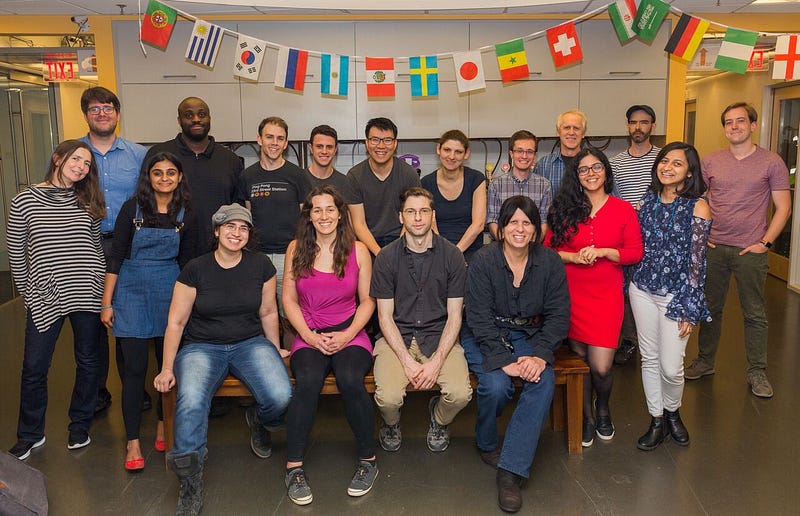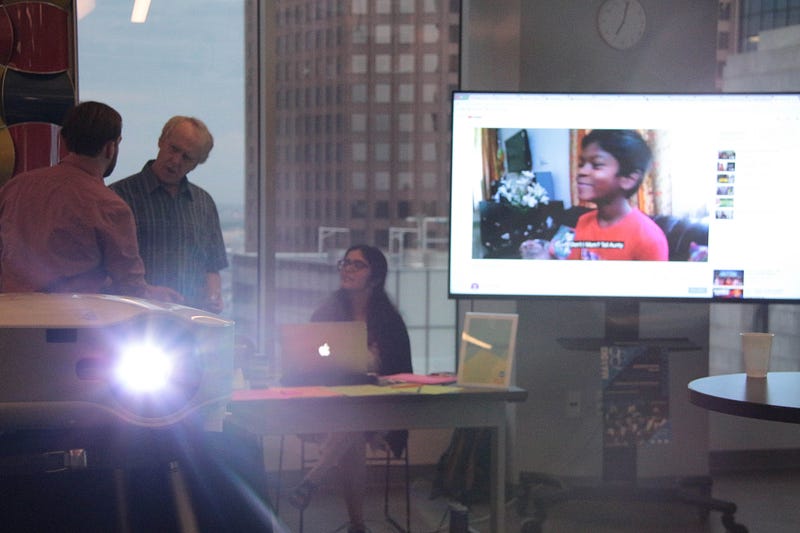How the gift economy helped me build the team for my interactive doc
 Developers,
UI/UX advisors, video & graphic artists, project leads from team Aashiyaan. See footer for
details.
Developers,
UI/UX advisors, video & graphic artists, project leads from team Aashiyaan. See footer for
details.When I travelled from India to be a Fellow at MIT’s Open Documentary Lab, I came carrying precious cargo — over 1 TB of footage culled from many phones. Some of it was grainy, some breathtakingly intense and some mundane. This formed the core of my interactive documentary Aashiyaan, which reveals New Delhi through the eyes of women whose stories are often excluded from mainstream narratives.
When I started my journey I was already held afloat by the voluntary work done by former students, assistant directors, editors, friends and even the children of my co-creators. Little did I know that my rite of passage into the world of i-docs in USA would involve more volunteers in the form of hackers.
Liani Lye and a few others are missing from the June 26 photograph above. Liani is the reason that I first found my way to the weekly pizza and hacking sessions organized by Code for Boston (CfB) in Cambridge, Massachusetts. A recent robotics major, she was focusing on “‘civic tech” and believed that her cohort at CfB would support my search for collaborators on the interactive documentary I was working on. As a Fellow at the Open Documentary Lab at MIT I had access to some of the brightest minds behind award winning and innovative XR projects, what I needed was a team that would support the work done by my co-creators from India — domestic workers and homemakers.
No, the beta version of the interactive app Aashiyaan, which is a result of weeks and months of voluntary labour, is not a donation from digital Robin Hoods. It is instead a product of an inspiring gift economy. As a meetup for “developers, designers, data geeks, citizen activists, and many others who use creative technology to solve civic and social problems” the CfB forum encourages a language of inclusion that is not only symbolic but also a social and relational embodiment. However, forming a team of regulars from a pool of volunteers is not easy. As Lewis Hyde points out in his book The Gift: Creativity and the Artist in the Modern World, “A gift economy allows its own form of individualism…Individualism in a gift economy inheres in the right to decide when and how to give the gift. The individual controls the flow of property away from [her/]him (rather than toward [her/]him, a different individualism).”
Many came and many went, but the hackers who stayed on to volunteer — coding, graphic design, video editing, photography, user interaction, project management and much needed cheerleading skills — stood by the social contract of the space. Knowledge, art and creative solutions are achieved only by gifting ideas, hours, experiences and stories. This is perhaps why differences in language, socio-economics, race and even gender did not deter these individuals from coming on board. The ethos that a “group mind” is critical to such a project helped steer the interactions of the group. We were in agreement. As Hyde writes, “Each individual thinker can be awash in the ideas of [her/]his comrades…so that one is capable of cognitive tasks beyond the powers of any single person.”
In practice this meant asking all the tough, honest and necessary questions that a filmmaker who wants to “use-code-to-tell-a-story” must be asked! Consequently, my wrists were also slapped when I helped myself to words that seemed commonsensical to me — scripts, design, user-stories, accessibility, etc.
Instead, I learned that scripts are a sequence of commands or instructions that would enable experiential and thematic associations between the video fragments I wanted to showcase. Design is a reusable pattern, which works as a solution and saves the developer hours of coding. Albeit defined from the perspective of an end user, user-stories are pithy descriptions of software features that enable developers to extrapolate the time and effort required to produce them. Accessibility is a UI/UX gold mine: a map of elements, their hierarchies and relationships. It determines how users will navigate, perceive and comprehend your work.
And there were the “users”! Swapping “audiences” and “stakeholders” with “users” was one of the most challenging processes for me. To think of a single user while designing navigational choices, graphic elements, language settings and screen sizes made me go back to the drawing board with the team repeatedly. Why were we creating a mobile app? How would we balance low bandwidth with the demands of the content?
Since this was an artistic endeavor and not a commercial product with immediately measurable impact and linear thought, a waterfall model of design couldn’t work. The process demanded that I lock down who I eventually hoped would interact with the app. This certainly wasn’t easy, since my co-creators belong to starkly diverse classes, castes, religions, regions and age groups. They also own different kinds of phones!
Defining the user was also crucial to developing the Minimum Viable Product, i.e. MVP. MVP can be described as an artifact that would be able to engage early adopters with minimum number of features. It enables a more agile testing of user choices and helps direct feedback for future iterations. As practical as it may sound, as entrepreneur Eric Ries observes on his blog Startup Lessons Learned, “MVP is quite annoying, because it imposes extra overhead. We have to manage to learn something from our first product iteration. In a lot of cases, this requires a lot of energy invested in talking to customers or metrics and analytics. Second…it is decidedly not formulaic. It requires judgment to figure out, for any given context, what MVP makes sense.” In the context of Aashiyaan, creating the MVP also meant sifting through the terrabyte of footage and choosing a precious few kilobytes.
Had it not been for the sage reminders of the hackers at CfB, I would’ve taken longer, and found it impossible to edit down to fragments and curate the version of the app (currently being readied for the play store). A quote with almost biblical significance that I was nudged towards was “Fail Fast. If you’re not embarrassed by the first version of your product, you’ve launched too late.” I’ve since repeated it with great impact to an art director, an engineer and a doctoral student.
The journey from rough cuts to prototypes and from prototypes to MVPs has been one of great learning for me. The journey from gifts to wealth is most certainly in the human resources that have helped realize Aashiyaan.
As we worked on the bilingual content of the app, a friend from CfB asked me how I would translate his identity — i.e. being a hacker — for native speakers in India. It didn’t take me too long to arrive at the word jugaadu, i.e. she/he who does jugaad. As improvisation to achieve a desired result, jugaad could be regarded as the Indian euphemism for an MVP.
In my documentary The Great Indian Jugaad (2010) I explore numerous connotations of the term. The consensus that emerges from the film is that jugaad is the spirit of finding a solution despite all odds. In a 1993 ethnographic study of a team of developers titled Artificial Intelligence as Craftwork, Lucy A. Suchman and Randall H. Trigg talk of “skilled improvisation” as ideating in a team such that material and cognitive possibilities can be realized despite constraints. For them, the whiteboard becomes a site for performing intellectual and emotional investment that in turn lead to “…concrete conceptual objects.” I have had the privilege of partaking in and witnessing such processes at CfB.
 User
testing Aashiyaan MVP 1 at CIC-Arts Technica 2018
User
testing Aashiyaan MVP 1 at CIC-Arts Technica 2018We were invited to participate in XR media fairs where we managed to test MVP 1. Heartened by the results, we set our sights on MVP 2. Every week, our numbers swelled and we gradually took up most of the space in the CfB hack nights.
As the project drew more hackers to the discussions and coding marathons, it became clear that Aashiyaan needed to become a transmedia experience eventually. This meant deep diving into those terabytes again. With each hour of engaging with the gift economy, the circulation of gifts we received increased. Several students, associates and friends from across the globe volunteered to translate the footage from Hindi, Bengali, Punjabi, Jharkhandi, Urdu and Haryanvi to English.
This is why I think it would only be fair if I were to end this account by revising my original count: Liani Lye and 39 others are missing from the photograph.
This article is dedicated to my dear friend Liani, who suffered an AVM-induced stroke during the making of the Aashiyaan app but continues to spare time from healing to volunteer with and support the Code for Boston community.
Pictured in the photo above: Sitting (left to right): Michelle Bernstein, Kristine Auwers, Byron Hinebaugh, Valerie Kenyon. Standing (left to right): Nika Vaks, Andrew Seeder, Ranjani Rajagopalan, Macsonny Onyechefule, Liam Morley, Tighe Carroll, Steve Man, Sasha Goldberg, Ian Hill, David McCaleb, Brian Sanders, Mike Yavorsky, Dhara Bhavsar and the author
Anandana Kapur is an award winning filmmaker and co-founder of Cinemad, India. Previously an executive producer for non-fiction programming on TV, she has worked on information and video campaigns for UNICEF, IYF and GOI. Anandana teaches courses on Documentary Practice, Films for Change and Activist Cinema. Her published work is on gender and film. A recipient of the Fulbright and Shastri Indo-Canadian Fellowships, Anandana is currently working on an interactive film. As a Fellow of the Open Documentary Lab at MIT she participated in and won a hackathon. She is happy to be an honorary member of the hackers’ tribe.
Immerse is an initiative of the MIT Open DocLab and The Fledgling Fund, and is fiscally sponsored by IFP. Learn more about our vision for the project here.